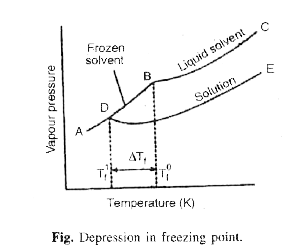Explain depression in freezing point. Show that it is a colligative property.
Text Solution
Depression in freezing point. The freezing point is the temperature at which the solid and liquid states of the substances have the same vapour pressure.
Since the addition of a non-volatile solute to the pure solvent lowers its vapour pressure, so the freezing point of a solution is expected to be less than that of the pure solvent. This is known as depression in freezing point. This has been represented graphically in Fig. The curves BC and DE represent the vapour pressure of the pure solvent and the solution respectively. The curve AB represents the vapour pressure of the solvent at different temperatures. At point B, the liquid solvent and the solid solvent meet, hence it corresponds to the freezing point of the pure liquid (ΔT∘f). Since the vapour pressure of a solution is always less than that of the pure solvent, the vapour pressure curve for the solution runs parallel

but below the pure solvent curve. The vapour pressure curve for the solution meets the solid solvent curve at D which corresponds to the freezing point of the solution Tf. It is evident that Tf is less than T∘f , indicating that there is depression in the freezing point of a solvent. Therefore, depression in freezing point,
ΔTf=T0f−Tf.
It has been experimentally found that depression in freezing point of a solution is proportional to the concentration of solute, i.e.
Δtf∝m
orδTf=Kfm
where Kf is the molal depression constant. It is also called molal cryoscopic constant.
|
Topper's Solved these Questions
- SOLUTIONSBook:MBD -HARYANA BOARDChapter:SOLUTIONSExercise:SATQ (SHORT ANSWERS TYPE QUESTIONS )
Explore 16 Videos
- SOLID STATEBook:MBD -HARYANA BOARDChapter:SOLID STATEExercise:LONG ANSWER TYPE QUESTIONS
Explore 10 Videos
- SURFACE CHEMISTRYBook:MBD -HARYANA BOARDChapter:SURFACE CHEMISTRYExercise:LONG ANSWER TYPE QUESTIONS
Explore 4 Videos
Similar Questions
Knowledge Check
Miximum depression in freezing point is caused by
Apotassium chlorideBsodium sulphateCmagnesium sulphateDmagnesium carbonateMaximum depression in freezing point is caused by
ANa2SO4BNaCl>BaCl2> GlucoseCGlucoseDKClAssertion : Depression of freezing point is a colligative property
Reason : The depression of freezing point for a solution is directly proportional to the molality of the solution.AAssertion is True, Reason is True, Reason is a correct explanation for AssertionBAssertion is True, Reason is True, Reason is NOT a correct explanation for AssertionCAssertion is True, Reason is FalseDAssertion is False, Reason is True
Define elevation in boiling point and show that it is a colligative property.
View Solution(i) Prove that depression in freezing point is a colligative property.
(ii) 45 g of ethylene glycol (C2H6O2) is mixed with 600g of water . Calculate the freezing point depression. (Kf for water = 1.86 k kg mol−1)
View SolutionDepression in freezing point or cryoscopy
View SolutionProblems based on depression in freezing point
View SolutionAssertion :- Elevation in boiling point and depression in freezing point are colligative properties.
Reason :- All colligative properties are used for the calculation of molecular masses.
View Solution

